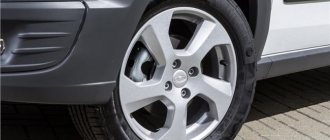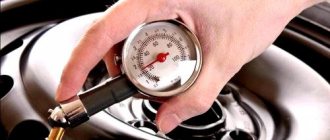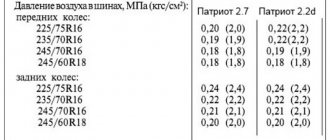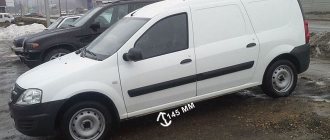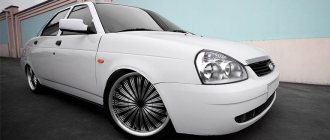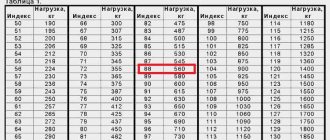The factory tire pressure on the Lada Largus differs from most models of the brand. The modern version for 5 and 7 seats is distinguished by a stiffer suspension and increased dynamics. To meet the specified characteristics, the manufacturer recommends pumping the wheels more. 2.4 - 2.6 BAR (atmospheres) for the front and rear axles is considered optimal. The manufacturer allows adjustments to the pumping of the slopes. In the summer, when the air temperature goes beyond +30⁰С, the tires need to be deflated. This will balance thermal expansion and stabilize the car's behavior.
In winter, on the contrary, you will need to constantly pump up the tires until the indicators normalize.
The driver can see the recommended pressure on the end of the left front door. There is an attached nameplate with complete information.
Tire pressure Largus Cross R15 – 185 65, R16 – 205 55
On a car where size 15 ramps are installed, in the summer it will be enough to maintain the pressure set by the manufacturer. For modifications with 7 and 5 seats, the input parameters will differ slightly. A more spacious car, it requires pumping up the rear wheels to 2.6 kilograms when fully loaded.
Separately, you should consider variations with 16-inch rollers. Here, low-profile slopes with a pumping level of 2.5/2.7 BAR are installed in the drain.
Review of the best summer and winter tires
When choosing tires, owners take into account the following points:
- manufacturer;
- operating conditions (pay attention to the pattern, tread);
- size;
- price category.
Based on reviews from Lada Largus owners, let's summarize.
The majority of survey participants adhere to the recommended sizes. The most popular non-standard tires are 195/65 R15, 195/60 R15, 205/60 R15.
- Nokian (HAKKA GREEN 2, Nordman SX);
- Michelin (Energy XM2);
- Continental (ContiPremiumContact 5);
- Matador (MP 44 Elite 3)
- Amtel (Planet T-301). Attention. Complaints about rapid wear. They can burst at high speed.
The tread pattern is:
- asymmetrical;
- directed;
- symmetrical (universal, therefore the most popular).
The latter is ideal for use around the city. It has an affordable price. The downside is unsatisfactory handling at high speed, on wet road surfaces, and when making sharp turns.
- Nokian;
- Michelin;
- Continental;
- Goodyear;
- Gislaved/Hankook/Bridgestone.
It is recommended to install standard winter tires. Studded or non-studded - depends on personal preferences and operating conditions. The first option is more popular among Lada Largus owners.
The pattern and tread height are important. You shouldn't skimp on winter tires.
"All-season" is not the best option. They lose to seasonal tires in most respects. In winter, there is a high risk of getting into an accident on such tires.
Application. Table from the instructions.
Source
How does low or high tire pressure affect
If the optimal level is insufficient, the tire sags in the central part of the tread, which leads to poor handling and intense wear of the tread shoulder.
With excessive inflation, the rubber bulges and only touches the central part. Problems associated with this also affect tire longevity and handling.
When maintaining proper inflation, the car drives smoothly, clings well to the road surface, and the slopes wear out slowly.
What non-standard sizes can be supplied?
Buy tires based on the full diameter of the wheel. It shouldn't be too different from the standard one.
Standard sizes allowed for installation.
| Model | Size, load capacity index | Center diameter wheel holes (DIA) | Radius between holes (PCD) | Number of nuts, pcs. | Wheel width, inches | Disc offset (ET) |
| R90 | 185/65R 15 88 H | 60,1 | 100 | 4 | 6J | 50 |
| F90 | 185/65R 15 92 H | 60,1 | 100 | 4 | 6J | 50 |
| CROSS | 205/55R 16 91 H | 60,1 | 100 | 4 | 5 ½, 6, 6 ½ J | 50 |
Attention. Replacing recommended sizes with acceptable ones will affect a number of characteristics. The dependence is shown in the table.
| Parameter | Increasing tire width | Increasing rim width |
| Keeping the car on the road | will improve | will improve |
| Accuracy of maintaining a given direction of movement | will improve | will improve |
| Road grip coefficient | will increase on dry roads | does not affect |
| Resistance to aquaplaning effect | will get worse | without changes |
| Traffic noise | will intensify | does not affect |
| Feelings when driving on rough roads | more comfortable | does not affect |
| Fuel consumption | will increase | will increase |
| Tire wear time | will speed up | without changes |
Be sure to calculate the load capacity index. Depending on the model, 88 (560 kg), 92 (630 kg) and 91 (615 kg) are allowed. The speed index is indicated next to the load capacity. T – up to 190 km/h, H – up to 210, V – up to 240.
An approximate formula will come in handy. Calculate the mass of the car, the weight of all possible passengers and cargo. Divide by 4 (wheels). Add a little extra.
Example: 1330 + 350 (passengers) + 170 (cargo) = 1850 / 4 = 462.5 kg + 40 = 502.5. In this case, a coefficient of 88 is acceptable. For summer tires, you will most likely need more.
Important! Installing large wheels can lead to incorrect operation of the ABS and electronic dynamic stabilization system of the vehicle.
The lighter the tires and wheels, the faster the vehicle accelerates. Thus, a car will accelerate to 100 km/h 0.2 seconds faster if the wheel weight is 2 kg less.
It is necessary to pay attention to the production date of the tire. Indicated on the side as a four-digit code. Explanation: the first two digits are the week of issue, the second are the year. The seller is obliged to sell tires within 5 years from the date of production (subject to proper storage).
Table of tire pressure standards for Lada Largus
Factory tire inflation rates are found in the table attached to each car. The nameplate is located on the end of the left door. At the same time, some buyers of used equipment may not find the element in its usual place. This usually happens after an accident. The door is being changed, but there is nothing like this on the repair samples.
| Tire size | Optimal pumping, BAR | |||||
| Fine | In summer | in winter | ||||
| Before | Back | Main | Minor | Presenters | Slaves | |
| 185/70 R14 | 2,4 | 2,6 | 2,3 | 2,5 | 2,6 | 2,7 |
| 185/65 R15 | 2,5 | 2,6 | 2,3 | 2,5 | 2,6 | 2,7 |
When a decrease or excess of pressure is allowed
There are situations in which violating the manufacturer’s recommendations is only for the benefit of the car. We are now talking about the contact patch, which increases with decreasing pressure in the tread and vice versa (decreases with increasing). When might this come in handy?
When driving on soft ground
By reducing the pressure by about one-fourth, you will thereby increase the contact patch by almost one and a half times. Accordingly, the movement will be easier, since the pressure on the soil will decrease.
Thanks for subscribing!
When driving on wet asphalt
By increasing the pressure, you will reduce the contact patch, which will reduce the risk of so-called aquaplaning. However, it should be noted that this rule does not apply to more modern tires, since they are initially designed to drain water.
When moving on rocky ground
In this case, the pressure can be increased, which will reduce the likelihood of damage to the tire sidewall. Don’t forget to return your blood pressure to normal after you’ve completed a difficult section of the trail.
To improve handling
By increasing the pressure, you can improve the car's handling and also reduce fuel consumption. However, you should not get too carried away with this, otherwise, in addition to all the advantages, you can get one rather significant disadvantage - an increased risk of a tire explosion.
Remember that blood pressure tends to decrease gradually, day after day. In summer it decreases a little more, and in cold weather, on the contrary, more slowly. Another important nuance is that some car models have different pressure levels on different axles. Do not forget to control the pressure and pump up the tires if necessary, and then driving will be safe for both you and others.
Lada Kalina is a front-wheel drive car representing the small class. The model replaced AvtoVAZ's budget products with rear-wheel drive. Its production has been carried out in Tolyatti since 2004.
Generation 2
In 2013, the second generation of Lada Kalina appeared. The car premiered at the Moscow Motor Show a year earlier. After 9 years of producing the debut generation, AvtoVAZ decided to refresh the model, making it more modern. As a result, Lada Kalina II received a new design, a revised range of engines and transmissions, a redesigned interior and a suspension with improved settings.
The eyeliner did the model good. The car has become more dynamic and increased in size. The second Lada Kalina is no longer a miniature city car, but a full-fledged class B hatchback. In this series, AvtoVAZ refused to produce modifications in the sedan body, offering consumers exclusively station wagons and hatchbacks. Other changes include revised front optics and an enlarged mesh grille. The openings for the foglights were also significantly enlarged.
The transformations also affected the interior. The interior of the new Lada Kalina has received higher quality finishing materials. Minor changes affected the center console. In the basic configuration, the list of equipment has become richer.
At the minimum, the car acquired front electric windows, 1 airbag and ABS. This version received a 1.6-liter 8-valve unit (87 hp). More top-end variations were equipped with a 1.6-liter 8-valve engine (98 hp) and a 1.6-liter 16-valve engine (106 hp). A “sport” version with a 118-horsepower unit was also offered. The power plants came in combination with an “automatic” or “mechanical”.
Don't skimp on security
The quality of rubber plays a very important role in safety issues. That is why you should not save where your health, and possibly your life, depends on it. Buy high-quality tires for your VAZ 2107 that provide excellent grip on the road surface. If you still decide to save money, buy good used tires from global manufacturers instead of low-quality consumer goods. As practice shows, such a solution is more profitable in all respects.
Pay attention to damage that tires receive during operation. Repairing them is not always possible
In some cases, it is better to completely replace the tire than to install a patch that could blow out at any moment and cause serious problems.
Repairing a tire causes the wheel to become unbalanced. Therefore, after vulcanization it is necessary to balance it, otherwise vibration may occur during movement, which negatively affects the elements of the chassis and leads to their premature failure. This operation is also necessary after disc repairs (welding, rolling) are performed.
Special attention should be paid to the seasonal change of tires on a VAZ 2107 car. In winter, special winter tires are used, which are softer, do not harden in the cold and provide reliable grip even on slippery surfaces
In addition, special floating studs can be packed into winter tires for driving in icy conditions.
However, you need to be careful when using studded tires in winter - excellent grip on ice is replaced by reduced stability on asphalt. And the wear of studs on asphalt accelerates
Experts say that high-quality winter tires provide better vehicle stability than studded ones.
Decoding tire markings
Each manufacturer of car tires has its own tire names, which make it possible to convey important information about the characteristics of tires to the end consumer. For example, very often the word ICE may appear in the names of winter tires, which will indicate that they are suitable for winter driving.
You can also find information about the maximum load on one wheel. Some manufacturers may include the phrase “Max Load” in fine print, which means the maximum weight allowed. This parameter can be either in kilograms or British pounds. In order to calculate this parameter, it is necessary to subtract 20% of the specified load in the case of installing tires on a passenger car and subtract 30% for SUVs.
The maximum permissible pressure to which the wheel can be inflated is also indicated on the tires. Over-inflating can lead to increased fuel consumption and possible tire rupture. The wheels may also indicate that such tires can be used in mud and on snowy roads. For this purpose there are designations in the form of Latin letters “M+S”. To designate winter tires, the inscription Winter is used, for tires resistant to aquaplaning - AQUATRED or AQUA CONTACT, all-season tires are indicated as an abbreviation AS, AW - suitable for any weather.
The most common marking for wheels is the designation of the profile width, as well as the ratio of the profile height to the width. This parameter is located immediately after the fraction with the profile size. The last data in this marking is the indication of the tire type and wheel diameter. This type of marking looks like this: 210/60R15.
What determines tire inflation?
Indeed, the pressure indicator is not a constant value; its change is influenced by several factors, three of which are the most important. The time of year and temperature changes must always be taken into account, so the driver must adjust the amount of air in the tires to suit the weather conditions.
The pressure in R16 tires in winter should always be higher than in summer. When heated, the air mass expands, and if the wheel is overinflated, it can explode. This rule also applies when choosing a driving speed, because the tire rubs against the asphalt and the temperature inside it becomes higher. So those who like to drive fast, and even in the hot season, need to remember their school physics lessons and monitor the tire pressure.
In winter, it is not recommended to senselessly reduce the pressure, as this can lead to disastrous results, but you also should not overinflate the tires. Winter tires are softer than summer tires, so the contact area between the tire and the road is larger. This allows you to drive your car more efficiently on slippery roads. When using all-season tires, sometimes you need to lower the ratings a little.
Tire pressure characteristics
The front and rear wheelsets are inflated differently, no matter whether it’s winter or summer outside. This rule is unshakable. Each car has a specific wheel size.
This information can be found in the vehicle's passport or on the nameplate located on the driver's door frame. The recommended pressure for such tires is also indicated there.
Each car has wheels of a certain size. This information can be found in the vehicle's passport or on the nameplate located on the driver's door frame. The recommended pressure for such tires is also indicated there.
Operating conditions are very important. If there is a snowstorm or thaw outside, then the pressure in the R16 winter tires should be reduced slightly. This is also recommended when driving on sand or on uneven rural roads.
This is also recommended when driving on sand or on uneven rural roads.
If there is a snowstorm or thaw outside, then the pressure in the R16 winter tires should be reduced slightly. It is recommended to do this also when driving on sand or on uneven rural roads.
What tire pressure should be in winter r19
We must not forget about the weight of the car when buying a new set of wheels, as well as its load capacity. Before you hit the road, you need to clarify what the tire pressure should be at the moment, under the given circumstances.
Permissible maximum tire and wheel sizes for Lada Largus
Here everything is limited only by the imagination of the car owner. However, the maximum wheel sizes at which the vehicle will be safe to operate are determined by the manufacturer, who also supplies such wheels from the factory.
That is, the largest wheel size that can be installed on Largus is 205/55 R16. If we move further, the car will require changes in design.
The fact is that the larger the disk or tire, the higher the likelihood that it will touch the fender liner or arch of the Lada Largus. Therefore, car owners resort to tricks for the sake of large rims - they reduce the tire profile.
As a result, the list of sizes is replenished with the following:
- 205/50 R17;
- 205/45 R17;
- 225/45 R17;
- 215/50 R17;
- 215/35 R18;
- 215/40 R18.
For off-road enthusiasts, it is recommended to increase not the diameter of the disk, but the rubber profile. To do this, it is more advisable to install wheels with the following parameters:
- 205/55 R16;
- 195/60 R16;
- 195/55 R16.
The larger profile allows you to move more comfortably over uneven surfaces and protects the disc from dents or cracks.

